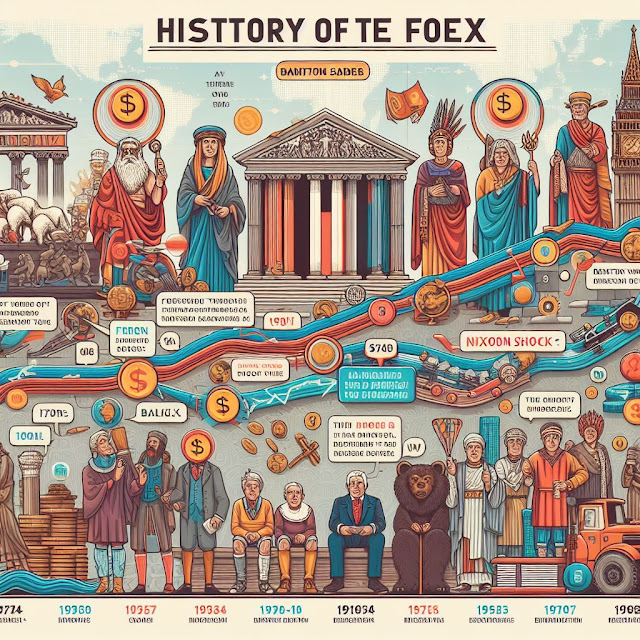When Forex Trading Started
Unveiling the Origins
A Deep Dive into the Inception of Forex Trading
In the vast landscape of financial markets, Forex trading stands as a cornerstone, facilitating the exchange of currencies on a global scale. The origins of Forex trading can be traced back centuries, evolving from the need for international trade and currency exchange. In this comprehensive guide, we will delve into the fascinating history of when Forex trading started, exploring its roots, pivotal milestones, and the transformation of the market into the bustling and dynamic arena we know today.
Early Beginnings: The Genesis of Forex Trading
1. Ancient Civilizations and Barter Systems:
The concept of trading dates back to ancient civilizations where communities engaged in barter systems. As trade expanded beyond local boundaries, the need for a standardized medium of exchange became apparent.
2. Emergence of Currencies:
With the rise of empires and trade networks, various forms of currency emerged. Ancient civilizations, including the Greeks, Romans, and Chinese, used coins made of precious metals as a medium of exchange.
3. The Gold Standard:
In the 19th century, the Gold Standard was introduced, linking the value of a country's currency to a specific amount of gold. This system provided stability but had limitations, especially during times of economic strain.
The Birth of Modern Forex: The Bretton Woods Agreement (1944)
1. Post-World War II Reconstruction:
After World War II, global leaders gathered at the Bretton Woods Conference in 1944 to devise a new international monetary system. The resulting Bretton Woods Agreement established fixed exchange rates linked to the U.S. dollar, which, in turn, was tied to gold.
2. The U.S. Dollar's Dominance:
Under the Bretton Woods system, the U.S. dollar emerged as the primary reserve currency. Other currencies were pegged to the dollar, and the dollar itself could be exchanged for gold. This marked the beginning of the modern Forex market.
3. Limited Speculation:
During this era, currency trading was restricted, and speculative activities were minimal. The primary focus was on maintaining the stability of exchange rates.
The Collapse of Bretton Woods and the Rise of Free-floating Currencies (1971)
1. The Nixon Shock:
In 1971, U.S. President Richard Nixon announced the suspension of the dollar's convertibility to gold, effectively ending the Bretton Woods system. This move led to the emergence of free-floating exchange rates.
2. Birth of Forex as We Know It:
With currencies no longer tied to fixed exchange rates, the Forex market transformed. Currencies started to float based on market forces, paving the way for increased speculation and the birth of the modern Forex market.
Technological Advancements and the Rise of Electronic Trading (1990s)
1. Digital Revolution:
The advent of the internet and electronic communication networks (ECNs) in the 1990s revolutionized Forex trading. It made the market more accessible, allowing traders to participate from anywhere in the world.
2. Forex Brokers and Retail Trading:
The rise of online Forex brokers facilitated retail participation. Individual traders, once limited to institutional access, could now open trading accounts with smaller capital.
3. Introduction of MetaTrader Platform:
The introduction of MetaTrader, a popular trading platform, further democratized Forex trading. It provided tools for analysis, real-time data, and automated trading, empowering individual traders.
Forex in the 21st Century: A Global Phenomenon
1. 24-Hour Trading:
One of the defining features of the modern Forex market is its 24-hour operation. The market opens in Asia, moves to Europe, then North America, creating a continuous cycle that caters to traders across different time zones.
2. Increased Liquidity and Accessibility:
The Forex market has evolved into the world's largest and most liquid financial market. Its accessibility has expanded, attracting a diverse range of participants, from institutional investors to individual traders.
3. Role of Central Banks and Governments:
Central banks and governments play a crucial role in influencing currency values. Monetary policies, interest rate decisions, and economic indicators contribute to market movements.
Conclusion
The Ever-Evolving Story of Forex Trading
The journey of Forex trading from ancient barter systems to the modern, interconnected global market is a testament to the evolution of human commerce. The inception of Forex as we know it today can be traced to pivotal moments in history—the Bretton Woods Agreement, the collapse of fixed exchange rates, and the technological advancements of the digital age.
As we navigate the complexities of the modern Forex market, it's essential to appreciate the historical underpinnings that have shaped its trajectory. From limited speculation under the Bretton Woods system to the democratization of trading through online platforms, Forex has become a dynamic and accessible arena for participants worldwide.
The story of when Forex trading started is a story of adaptation, innovation, and the continuous quest for efficiency in the ever-changing landscape of global finance. As we look to the future, the narrative of Forex trading is sure to unfold further, influenced by technological advancements, geopolitical shifts, and the collective actions of the diverse participants who contribute to this fascinating tapestry of international exchange.


.jpeg)





